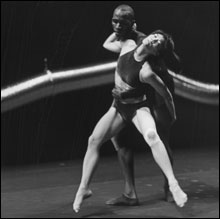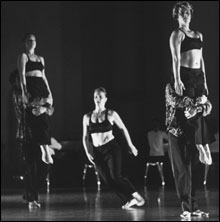
IN THIS DREAM THAT DOGS ME: Movement so inventive you couldn't even call it eclectic.
|
Performed on the chapel lawn at Concord Academy a week ago Thursday, Anna Myer’s All at Once utilized a sculptural, gestural movement idiom, but it looked more like a ballet than a modern dance. Karole Armitage’s In this dream that dogs me, which followed the Myer piece in the theater at Summer Stages Dance, was rigorously ballet-based, but it looked as if every move had been newly made up.
In theory, an outdoor venue always seems like an exciting prospect, and sometimes it repays prior anxieties about the weather, the insects, and the hazards that might be lurking underfoot for the dancers. The rain and the bugs held off on Thursday; the grass was thick and soft. But somehow Myer’s piece came loose in the big green space.
Shown in the top-floor studio at Boston Ballet back in May 2005, All at Once proposed a synthesis of music and movement. From different parts of the room Susan Davenny Wyner conducted 12 New England Ensemble string players. The dancers remade the spatial layout three or four times by shifting the violinists’ stools and music stands into expansive rows and arcs, so unlike the usual bunched-up, audience-oriented musical concertizing. Maybe the architecture of the studio itself created a frame for these choreographed rearrangements. At any rate, the dance looked more focused there, and more energized.
Myer’s nine dancers, after attending to and escorting the musicians to their new stations, moved through the twilight lawn in her variations on movement themes that seemed built on expanding and reorienting a few gesture patterns. When not dancing, they’d stand formally around the edges of whatever musical space they’d configured. Of course there was nowhere for them to exit, but I think their constant witness was part of the plan. Jakov Jakoulov’s post-romantic music, discreetly miked, provided a porous, pleasant background.
Sometimes prompted by a soloist, the dancers worked in small and large units, always neatly designed and of a piece with the staged furniture moving, the choreographed waiting and walking. Leading with one protectively curved arm, they’d travel and turn, stretch out and roll to the ground. A partner would slide an arm around someone’s waist from behind and they’d scoop sidewards together. With a grave handshake, they’d lead sideliners into center space.
ADVERTISEMENT
 |
In one of two climactic moments there was a false ending, as the music trembled to a dissonant screech and the dancers gathered in a tight group and reached skyward. Then, encircled by standing violinists, they reprised the movement themes and came to a sudden stop with the music.
Whether Davenny Wyner was stationed opposite the ensemble, or on some faraway steps, or in the center of the final circle, the musicians were always intent on their leader. But the dancers often aimed all their patterns at the audience that was watching from one end of the lawn, as if the dance were taking place in a proscenium theater. This divided focus, which I never noticed in the indoor version, drew my attention to the dance’s sparse movement material and the noncommittal way the dancers performed it.
Maybe it was the grass, muting their footfalls, checking their momentum, but the performance seemed a bit bloodless. Or maybe its cool formalism suffered next to the extraordinary dance by Karole Armitage that followed.
Armitage has returned to New York with a new company after a decade and a half in Europe. Before that, as a former Merce Cunningham dancer, she’d begun a choreographing career — a punked-out fusionist, doing bizarre things with pop art, pointe shoes, and a lot of attitude. She still has the spiky hair and the yen for offbeat titles. (The new company is called Armitage Gone! Dance.) She still makes dance that’s overflowing with movement. But at least in the piece she brought to Concord, the contrarian flamboyance had subsided, leaving behind a stupendous residue of movement so inventive you couldn't even call it eclectic.
Armitage collects her source material from modern dance and ballet and Cunningham, from fashion photography and martial arts, body work and fitness regimens, gender-stereotyped behavior and Hollywood motifs. It’s all sewn together in a continuous fabric of highly charged physicality. Sometimes an actual step will assert itself. Out of a speedy blur of extensions and direction changes a perfect attitude turn gets incised and immediately erased. A woman being maneuvered in the air by three men suddenly sprouts a svelte arabesque. Most of the time, though, the specifics don’t distinguish themselves from the mass of movement.

ALL AT ONCE: Losing focus outdoors.
|
Armitage says she doesn’t tell stories, but this means that on the simplest level she doesn’t depict princes and princesses. What she does deliver is an engrossing scenario of interaction among five dancing personalities. Theresa Ruth Howard, who looks like a champion athlete and acts like a dramatic diva, engages in a long, possibly competitive, possibly erotic set of games with three men: tall, smoldering William Isaac, tall, reticent Brian Carey Chung, and small fiery Leonides D. Arpon.
Their dialogue of reconnoitering, reconnecting, and rebalancing seems to race by at top speed, but it’s punctuated by many changes of energy, unpredictable stops, luxuriant stretches with flipped or wiggly accents at the edges, punches thrown and limbs caressed. At a touch by Chung, Howard slows down and they do a duet of sensuous holds and lifts. She leads him holding his chin. You don’t feel either one of them is taking advantage of the other, but there are moments when both of them seem shockingly exposed.